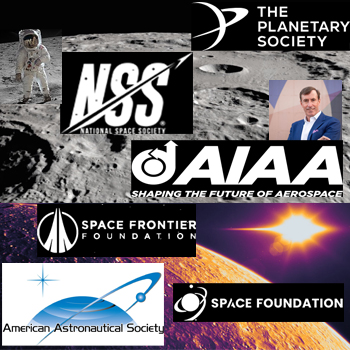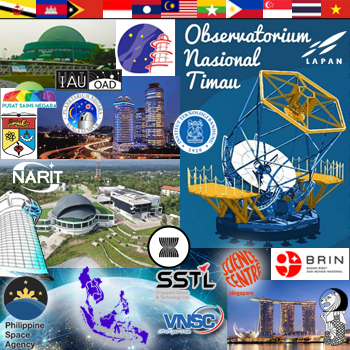American Space Movement: AIAA, AAS, NSS, SFF, PS, SF Active Now and In the Future
|
MONDAY☆ Nov 4 — International Space Station, ~415-km LEO: Expedition 72 seven-member crew receives 31st commercial resupply mission by SpaceX to forward port after relocation of Crew-9 Dragon to zenith port; brings food, supplies, scientific materials including Coronal Diagnostic Experiment, Antarctic moss; payload mass ~6,000 kg. ☆ Nov 4 — Tiangong Space Station, ~390-km LEO: Shenzhou-18 three-member crew return to Earth after welcoming Shenzhou-19 crew; Commander Cai Xuzhe, Taikonauts Song Lingdong and Wang Haoze preparing for 6 month mission aboard; Wang is China’s third woman to work in the TSS; Taikonauts will be assisted by 2 mini-drones nicknamed Xiao Hang and Xiao Tian, which take pictures / videos, help with resources management via voice control. ☆ Nov 4 — Rocket Lab, Launch Electron / Changes In Latitudes, Changes in Attitudes, Rocket Lab Launch Complex 1B, Mahia Peninsula, New Zealand: Satellite to SSO for undisclosed customer; launch cost ~US$6M, live stream, 00:30 HST. ☆ Nov 4 — Roscosmos, Launch Soyuz 2.1b Fregat-M / Ionosfera-M 1&2, Cosmodrome Site 1S, Vostochny Cosmodrome, Siberia, Russia: Constellation of 4 research satellites to SSO, each with 9 instruments, altitude ~800km; launch cost ~US$48.5M, 13:18 HST. ★ Nov 4 — SpaceX, Launch Falcon 9 / Dragon CRS-2 SpX-31, LC 39A, Kennedy Space Center FL: 31st commercial resupply by SpaceX to ISS; 16:29 HST. ★ Nov 4 — SpaceX, Launch Falcon 9 / Starlink Group 9-10, Space Launch Complex 4E, Vandenberg SFB CA: Satellites for Starlink mega-constellation; launch cost ~US$52M, NET 15:29 HST (launch window open 4 hours). o Nov 4-6 — Pangea Global Events (PAGES), Online: International Conference on Space Science and Communication; based in India and USA, PAGES scientific board members are from China, France, Italy, Portugal, Turkey, UAE, USA; event has 10 plenary / 8 keynote speakers; via Zoom, US$399-$1,099. |
 |
● = Terrestrial and… o = International terrestrial events
☾ = Moon activity ★ = Space and… ☆ = International space / astro events; in Hawaii Standard Time unless noted. Add 10 hours to obtain UT (‘Universal Time’). |
Weekly Planet Watch – Evening Planets: Venus (W), Mercury (W), Jupiter (ENE), Saturn (SE), Uranus (N), Neptune (E); Morning Planet: Mars (S).
Southeast Asia Expands Space Activities with ILRS & Artemis Accords Signing, Astronomy, Commercial Space
Geo-Informatics and Space Technology Development Agency (GISTDA) of Thailand becomes the latest to sign the (now 47-signature strong) international Artemis Accords (led by USA), while National Astronomical Research Institute of Thailand (NARIT) has been working since September 2023 with the China-led International Lunar Research Station. This is an inspiring move by Thailand – contributing to peaceful, scientific exploration of the Moon within both international frameworks. NARIT is developing its first Moon payload, a 3-kilogram instrument to study solar storms and cosmic rays, for launch aboard Chang’E-7 orbiter ~2026. Thailand’s most comprehensive astronomy learning center, Princess Sirindhorn Astro Park, is operated by NARIT, as is the 2.4-m Thai National Observatory atop Doi Inthanon and the new 40-m, single-dish Thai National Radio Telescope in Chiang Mai. Singapore groups making waves in aerospace are Singapore Space and Technology Limited (host of one of the largest industry events, GSTC), Transcelestial Technologies (developing wireless laser space comms), Qosmosys (planning a lunar landing NET 2028, received a US$100M investment), Space Faulty (creating opportunities for experimentation, learning and leadership), and the national Office for Space Technology & Industry Singapore. LAPAN in Indonesia is planning to build a spaceport on Biak Island, taking advantage of equatorial flight paths over low-to-no population zones. Indonesia is also developing Timau National Observatory and VLBI Global Observing System. According to an ISI report, Vietnam and Malaysia have doubled in science research output in the last decade. (Image credits: NARIT, LAPAN, SSTL, VNSC, PSA, ITB, et al) |
Ongoing… ● Sep 4 – Nov 25 — NASA, Online: Lunar Navigation Challenge; ahead of Artemis mission, 2 prizes available for invention of orienteering aid and device to map bottom of Shackleton Crater. ● Nov 1-15 — Astronaut Scholarship Foundation, Online: Space Memorabilia Auction. ★ NET Nov — Blue Origin, Launch New Glenn / Blue Ring, LC 36A, Cape Canaveral SFS FL: Maiden New Glenn flight, to carry Blue Origin Blue Ring payload tug; initial USSF National Security Space Launch certification flight. TUESDAY☆ NET Nov 5 — Roscosmos, Launch Soyuz 2.1b Fregat-M / Ionosfera-M 1 & 2, Vostochny Cosmodrome Site 1S, Siberia, Russia: Under project Ionozond, launch constellation of 4 ionospheric / magnetospheric satellites to SSO at altitude ~800 km, same suite of 9 instruments on each, launch cost ~US$48.5M. ● Nov 5 — Lunar and Planetary Institute, Universities Space Research Association, Online / Houston TX: Abstracts Due: Itokawa and the Dawn of Asteroidal Sample Return Workshop; being held Jan 28-30, 2025. o Nov 5-7 —Asia-Pacific Satellite Communications Council, Bangkok, Thailand: APSCC 2024 Satellite Conference and Exhibition; 500+ attendees, 130+ speakers, 150+ companies; at Chatrium Grand, US$1,050-1,500. ☆ Nov 5 — Apollo Asteroid (2024 UH5): Near-Earth Flyby (0.004 AU) WEDNESDAY★ Nov 6 — Parker Solar Probe, Heliocentric Orbit: 7th and final planned Venus fly-by today to slow it for approach to Sun; launched 2018, craft named for Eugene Parker of University of Chicago. ● Nov 6 — Virgin Galactic (NYSE: SPCE), Online: Third Quarter 2024 Financial Results Telecon; 17:00 EST. ● Nov 6 — NASA, Online: SSERVI CASA Moon Planetary Sample Science Seminar, Thomas Kruijer of Lawrence Livermore presents “High-resolution chronology for crustal magmatism on the Moon”; 08:00-09:00 HST. ● Nov 6 — American Institute of Aeronautics and Astronautics, Online: Space Healthcare Call for Content Webinar; to introduce new topic for 2025 ASCEND Conference to be held Jul 22-24. o Nov 6-8 — Canadian Space Health Research Network (CSHRNet), University of Calgary, Western Institute for Earth & Space Exploration, Western Bone and Joint Institute, et al, London, Ontario, Canada: 2024 Canadian Space Health Research Symposium; for scientists / researchers investigating the effects of spaceflight on human health. ☆ Nov 6 — Apollo Asteroid (2024 UW): Near-Earth Flyby (0.004 AU) |
THURSDAY
★ Nov 7 — SpaceX, Launch Falcon 9 / Starlink Group 6-69, Space Launch Complex 40, Cape Canaveral SFS FL: Satellites for Starlink mega-constellation; launch cost ~US$52M, NET 12:53 HST (launch window open 4 hours).
● Nov 7 — American Institute of Aeronautics and Astronautics (AIAA), Online: Aerospace Perspectives Series: Inspecting Parts With Rapid, Automated and High-Volume Industrial CT Scanning; presented by co-founder of Lumafield, Kevin Cedrone, 08:30 HST.
● Nov 7-8 — National Academies of Sciences, Engineering and Medicine, Irvine CA: Meeting of the Committee on Astronomy and Astrophysics.
FRIDAY
● Nov 8 — NASA, Online: Crew-8 Astronauts discuss mission in news conference; on NASA TV, 10:15 HST.
● Nov 8-9 — National Space Society, Astronauts Memorial Foundation, Center for Space Education, Kennedy Space Center FL: 2024 Space Settlement Summit; for interactive workshops / discussions / presentations about policies to encourage thousands of people to work and live in space.
☾ Nov 8 — Moon: At first quarter, 19:55.
SATURDAY
☆ Nov 9 — CNSA, Launch Long March 2D / multi-payload, Jiuquan Satellite Launch Center, China: Multiple Synthetic Aperture Radar (SAR) and optical satellites (Hebi 4..6, Longyuan Shuili 1 and Zhongyuan 2) to be launched.
● Nov 9 — American Institute of Aeronautics and Astronautics (AIAA) Los Angeles Section, Hawthorne CA / Online: Presentation: Safe Active Fault Estimation for Spacecraft by James Ragan, Caltech Space Engineering PhD candidate; Exhibit: Gran Systems; 10:30-12:40 PST.
SUNDAY
☆ NET Nov 10 — CNSA, Launch Long March 7 / Tianzhou 8, Wenchang Spacecraft Launch Center, Hainan, China: Next supply ship for Tiangong Space Station crew, Shenzhou-19, to be launched with about 7,400 kg of cargo including bricks made from lunar regolith simulant.
☾ Nov 10 — Moon: 0.21° NE of Saturn / occultation, 16:00.
☆ Nov 10 — Mercury: 1.98° N of Antares, 01:00.
☆ Nov 10 — Apollo Asteroid (2024 UC3): Near-Earth Flyby (0.028 AU)

